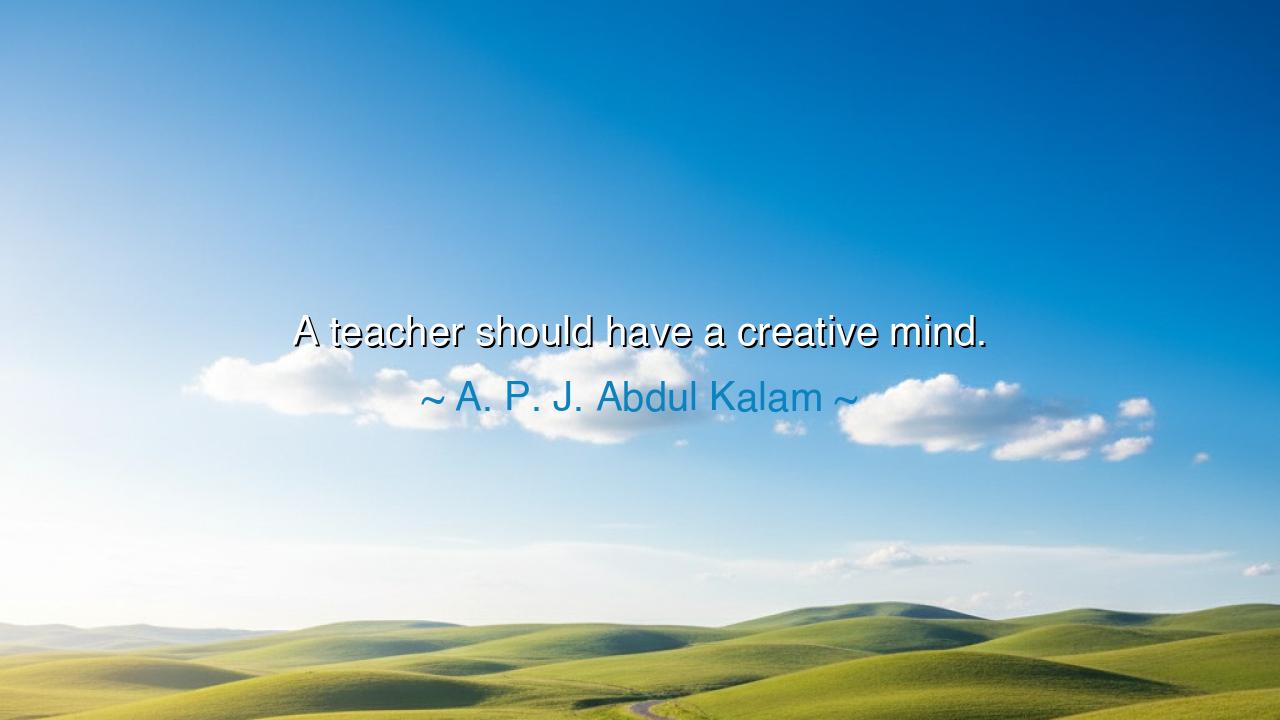
A teacher should have a creative mind.






A. P. J. Abdul Kalam, the great teacher, scientist, and leader of India, once said: “A teacher should have a creative mind.” In these few words, he revealed a truth that touches the very roots of learning and wisdom. For a teacher is not merely a vessel of facts, nor a custodian of rules; a teacher is a guide, a builder of minds, and a nourisher of souls. To teach without creativity is to pass along lifeless stones; but to teach with a creative mind is to ignite sparks that grow into living fire. The words of Kalam carry not only advice, but a commandment for all who would shape the next generation.
The origin of this wisdom lies in Kalam’s own life. Born into humble circumstances, he rose to become a scientist who lifted rockets toward the heavens and later a president who uplifted the spirit of a nation. Yet he never ceased to see himself first as a teacher. He understood that to inspire youth, one must do more than repeat what is already written; one must show new possibilities, kindle curiosity, and open paths where none seemed to exist. For him, creativity was not an ornament of teaching, but its lifeblood—the difference between memorization and true awakening.
The ancients knew this truth well. Socrates, who never wrote a single book, taught through questions—leading his students to discover truth not by rote, but by the creative act of thinking. Confucius, in his wisdom, adapted his lessons to the needs of each disciple, seeing not identical vessels but unique souls with different strengths. These masters understood that a creative mind in the teacher awakens a creative flame in the student. Knowledge may be transmitted by the book, but wisdom is breathed into life only by a mind that imagines, adapts, and inspires.
Consider the story of Maria Montessori. In an age when children were seen as passive recipients of instruction, she envisioned classrooms alive with exploration. She gave children tools to learn through touch, sound, and movement, rather than through endless repetition. Her creative mind transformed not only her own students, but education across the world. Where others saw children who must be shaped, she saw explorers who must be guided. Her work stands as a living testimony to Kalam’s truth: that the teacher’s creativity is the root of the student’s growth.
Thus, the meaning of Kalam’s words is this: a teacher without creativity may preserve knowledge, but a teacher with creativity multiplies it. Facts can be memorized, but curiosity cannot be commanded; it must be inspired. The true strength of a teacher lies not in what they know, but in how they awaken the minds of others to seek, to question, and to imagine beyond the boundaries of what is given. The creative teacher does not simply raise students; he or she raises creators, inventors, dreamers, and leaders who will shape the future.
The lesson for us is clear: in every role of teaching—whether as a parent, mentor, or guide—we must cultivate creativity within ourselves. Do not be content with repeating the words of others. Seek new ways to explain, to inspire, to demonstrate. When one method fails, invent another. When a student falters, search for the hidden path that will reach their heart. For teaching is not a machine of repetition; it is an art, a living dialogue between minds.
In your own life, practice this wisdom by nurturing your creative mind. Read widely, observe nature, ask questions, and imagine possibilities. If you are a teacher, weave stories into your lessons, connect ideas to real life, and show your students how knowledge breathes in the world around them. If you are not a teacher by profession, remember that every word you share and every action you model is itself a form of teaching. Approach it with the imagination that gives life, not the rigidity that stifles it.
Therefore, remember Kalam’s command: “A teacher should have a creative mind.” For in the creativity of the teacher lies the awakening of the student. In the creativity of one mind lies the future of many. And in the creativity of many minds lies the destiny of nations. Let us then not be mere transmitters of what has been, but creators of what may yet be—teachers whose minds shine like torches, lighting the way for generations to come.






AAdministratorAdministrator
Welcome, honored guests. Please leave a comment, we will respond soon